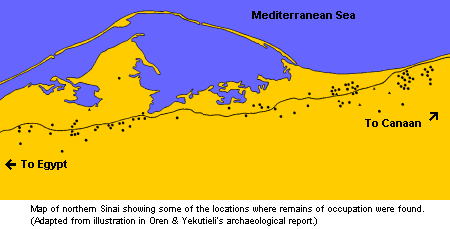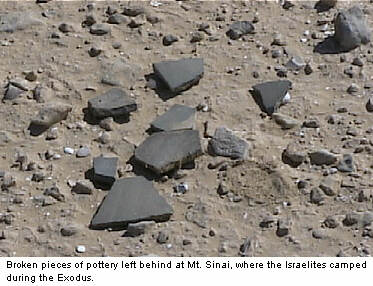
|
|
|
|
|
|
Home
About
Resources
anti-aging vitamins books
- A New Approach...
- The Exodus Happened 2450 B.C.
- Noah's Flood Happened 3520 B.C.
- Age of the Earth Collection
- Aging: Cause and Cure
- Bread from Heaven: The Manna Mystery Solved
newsletters
podcast
speaker for an event
time charts
videos
Topics
Overview
Biblical Chronology Dendrochronology Radiocarbon Dating Mt. Sinai Jericho Ai The Exodus Noah's Ark Imhotep/Joseph
Correspondence
- anti-aging vitamins
- antiquity of mankind
- ark search
- Bible chronology
- "The BC" publication
- Bryant Wood's critique
- calendars
- Heshbon
- horses and chariots in Egypt
- Jericho --- Joshua's curse
- lifespan research
- missing millennium: reception
- missing millennium: textual
- Mt. Sinai
- Noah's Flood
- Philistines
- radiocarbon
- Sodom and Gomorrah
- teaching science and creation
- the Exodus
- tree rings
- virtual history
- young earth creation
Contact Us
Is there any evidence of the Exodus in the Sinai wilderness?The following article is based on research reported on in The Biblical Chronologist Volume 1, Number 6 and The Biblical Chronologist Volume 2, Number 1. Full details and references to the scholarly literature can be found there.Missing Pottery?The March 9th, 2002 issue of the New York Times included an article titled "As Rabbis Face Facts, Bible Tales are Wilting". The article reported that many Jewish rabbis are now teaching that the early stories of the Old Testament never actually happened---that they are myths, not real history. The article began this way: Abraham, the Jewish patriarch, probably never existed. Nor did Moses. The entire Exodus story as recounted in the Bible probably never occurred. The same is true of the tumbling of the walls of Jericho...Quoting Rabbi Wolpe, it went on to say: Archaeologists digging in the Sinai have `found no trace of the tribes of Israel---not one shard of pottery'. This is a serious claim. If the Bible's story of the Exodus is true---if about two million Israelites traveled across the Sinai wilderness on their way to Canaan, as the biblical story leads one to believe---there should certainly be a trail left behind, marked mainly by pieces of broken pottery. The claim is that no such pottery has been found in the Sinai, and thus the Bible's story of the Exodus must be false. In point of fact, pottery from the Exodus has been found---lots of it. The archaeologists don't recognize it as Exodus pottery because their dates for the Exodus are out by a full thousand years. (Please note that archaeologists are not chronologists.) When the dates are put right, an abundance of pottery evidence for the Exodus suddenly appears. The EvidenceFrom 1972-1982 the Ben-Gurion University (in Israel) conducted an extensive archaeological survey of the northern Sinai area. They documented 284 sites in northern Sinai where pottery shards and other remains of ancient occupation were found. These sites were arranged in groups with larger sites in the center and smaller sites on the outer edges of the group. They found that the larger center sites were "base sites" where central activities (such as buying and selling) occurred, that the medium-size sites were family living areas, and the small outer sites were encampments for shepherds. They found that the people who lived at these sites were nomadic, wandering from place to place. They said "In most of the sites there is no evidence of solid building, and it looks as if the inhabitants lived in booths, tents, or lean-tos."  Gerald E. Aardsma, Ph.D., showed back in 1995 that these encampment sites were made by the Israelites early in the Exodus. They reveal, in fact, the first three stops along the route of the Exodus: Succoth, Etham, and Pi-hahiroth. These Sinai sites fit the Biblical account very well.  Chronological IssuesSo why do most archaeologists say the Exodus never happened? Because the pottery they've found in the Sinai is from about 4,500 years ago, while the traditional date for the Exodus is only about 3,500 years ago. They assume that this pottery must not be from the Exodus because of its date. But the traditional date for the Exodus is wrong. Dr. Aardsma has shown that a full millennium has accidentally been overlooked by biblical chronology scholars in the past. (See What is the missing millennium discovery?) When the overlooked millennium is restored to biblical chronology, the problem of the missing Exodus pottery shards disappears. ConclusionBecause the archaeologists have been looking for the Exodus in the wrong time period, they haven't found it. Unfortunately, they have then gone on to conclude that the Exodus must never have happened. This is the wrong conclusion. When you look in the right time period, there's plenty of evidence to show that, in fact, the Exodus did happen, just as the Bible describes it. The foregoing article was based on research reported on in The Biblical Chronologist Volume 1, Number 6 and The Biblical Chronologist Volume 2, Number 1. Full details and references to the scholarly literature can be found there. |